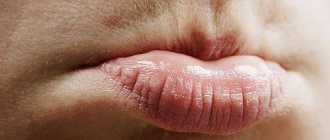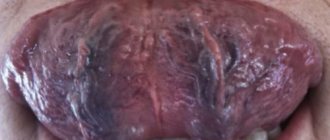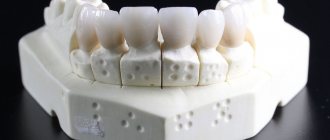A snow-white smile today is considered a mandatory attribute of beautiful appearance. Therefore, when black spots appear on the teeth, there is a desire to get rid of them as soon as possible. But first you need to understand the reason for the appearance of blackheads. Why the enamel darkens, whether it could be caries, we will tell you in the article.
In this article
- Is a black dot on a tooth a caries?
- What is black caries?
- Spots on teeth due to fluorosis
- What to do if large or small spots appear on your teeth?
- How to treat caries in the form of spots on teeth?
- Prevention of caries and dark spots on teeth
Is a black dot on a tooth a caries?
There is a widespread belief that black spots on teeth are always caries. A dental disease that begins with the loss of mineral substances by the enamel and is accompanied by the gradual destruction of hard tooth tissues. Indeed, stains on a tooth can be signs of early caries. But this is only one of the possible reasons.
Various factors can lead to a change in enamel color:
- Poor oral hygiene, improper brushing of teeth, resulting in the formation of plaque and tartar on the enamel surface, which leads to the destruction of the tooth structure.
- Regular consumption of coloring foods and drinks, in particular coffee, black tea, Coca-Cola. They stain the enamel, which leads to its darkening.
- Smoking. The tars contained in cigarette smoke settle on the tooth enamel, resulting in a dark stain of plaque that cannot be removed even with daily brushing.
- Diseases of the gastrointestinal tract disrupt the acid balance in the oral cavity. Because of this, the enamel loses strength, becomes more sensitive and darkens.
- Black spots may be associated with wearing braces and dentures. In this case, dark spots form in areas of contact with orthodontic structures due to metal oxidation, poor hygiene or an allergic reaction.
- Another cause of dark spots on teeth is erosion of tooth enamel, which, contrary to popular belief, is not associated with tooth decay. This dental pathology must be treated. Without treatment, the black spot grows, the enamel is gradually worn away, and erosion affects the deeper layers of the tooth.
- Injury. With a strong blow to the front teeth, the pulp tissue - the neurovascular bundle - can be torn and injured. As a result, a hematoma forms, which causes the tooth to turn black.
- Other reasons. Less commonly, the appearance of black spots and stains on teeth is due to prolonged use of medications, weakened immunity, and hormonal imbalance.
Only a dentist can determine why black spots appear on the teeth, whether they are caries or not. Therefore, for any darkening of the enamel, be sure to consult a specialist.
Teeth whitening at home
At home, you can try to whiten your teeth with products that are available in every home.
- Make a paste from activated carbon, which must be ground into powder and mixed with a small amount of soda, adding a few drops of water to it and stir the composition until it becomes a paste. Apply this “Paste” to your teeth and brush them.
- Lemon juice and soda. Add some baking soda to lemon juice and brush your teeth with this mixture. You can brush your teeth with this product for 1-3 months.
Getting rid of brown stains at home can only be used as an additional means that is used when undergoing a medical course of dental treatment, in a dental office. Therefore, the most ideal option would be to contact a specialized dental clinic.
What is black caries?
There is no such term as black caries in dentistry. But among ordinary people this is the name given to the stage of the carious process at which the teeth darken. How does this happen?
“Black caries” may be at the initial stage. In this case, first white and then black dots form on the surface of the enamel - areas of demineralization. In these places, the enamel is thinned and vulnerable to the damaging effects of acid. If you do not pay attention to the blackheads in time and do not treat them, then the caries will go deeper and spread to the dentin.
Sometimes “black caries” is a carious lesion in which a hole has already formed in the tooth. Bacteria produce organic acids and gases, which not only destroy the structure of tissues, but also stain them. With caries, black spots can even show through tooth enamel.
Preventive measures for “white caries”
The main component of dental health and prevention of caries development is compliance with the rules of prevention:
regular and proper oral hygiene. It is necessary to brush your teeth not only with a brush, but also after each meal you should use dental floss. After removing pieces of food with a thread, it is advisable to chew chewing gum for 5 minutes;
- Maintain a nutritious diet and try to avoid frequent snacks between meals. A common cause of caries is frequent consumption of sweets, flour, candies, chips, fast foods, and carbonated drinks. For dental health, the diet should contain fish, vegetables, fruits, kefir, nuts, cottage cheese, milk and other products with a high content of fluorine, phosphorus and calcium;
- periodically carry out professional teeth cleaning and treat the enamel with fluoride-containing preparations.
If you follow these basic rules, you can keep your teeth strong and healthy. But in order to avoid complications and prevent the pathology from becoming severe, you need to regularly visit the dentist and, if necessary, carry out proper and effective treatment of caries in the spot stage.
Spots on teeth due to fluorosis
It is generally accepted that fluoride is a microelement beneficial for teeth, because it strengthens tooth enamel, increases its protective properties, and prevents the leaching of calcium. But with an excess of fluoride in the body, a disease such as fluorosis can develop. It causes destructive changes in the hard tissues of teeth. Fluorosis is typical for residents of regions where drinking water is fluoridated, as well as for those who constantly brush their teeth with fluoride paste and eat a lot of fluoridated foods. One of the most striking signs of the disease are spots on the enamel. At first they are light, but as the pathology develops they become yellow or dark brown.
Teeth with fluorosis lose strength, chewing surfaces quickly wear away, chips and areas of erosion may appear, and sometimes the disease leads to complete destruction of the dental crown. The choice of treatment method depends on the degree of tooth decay.
Why can baby teeth turn black?
Baby teeth are much more susceptible to caries than molars, since they do not have such a dense structure. Enamel can change color due to the development of various pathological processes that can be provoked in a child:
- fragility of tooth enamel;
- calcium deficiency;
- improper oral care;
- chips and cracks in the enamel;
- vitamin deficiency;
- endemic fluorosis;
- chronic gastrointestinal diseases;
- genetics.
Sometimes the cause of darkening of the teeth of very young patients is artificial feeding of the baby at night. Consuming formula or milk at night reduces saliva production. The acid that accumulates on the teeth during feeding is not washed away by saliva and the process of destruction of tooth enamel begins.
What to do if large or small spots appear on your teeth?
Any changes in the color or structure of tooth enamel are a reason to be wary and seek advice from a dentist. Only a doctor, after diagnosis, will be able to accurately answer the question: is a blackhead a symptom of caries? Or the darkening occurred for another reason.
If a stain on the front teeth occurs as a result of a bruise, the dentist will remove the affected tissue, process and fill the canals, and, if necessary, recommend installing veneers or endo-whitening (lightening the tooth from the inside).
If the cause of dark spots is poor hygiene or poor plaque removal, professional cleaning using ultrasound or laser will help solve the problem. These methods are good at removing plaque and tartar from the enamel surface and returning the teeth to their natural shade.
If food coloring is the cause of teeth staining, professional hygiene combined with a subsequent whitening procedure can help.
Unfortunately, dark spots on teeth are caries in the vast majority of cases, and the carious process at any stage requires immediate treatment.
Types of plaque
Plaque on teeth is divided into two large groups:
- the occurrence of which is associated with external contamination of the tooth;
- appearing due to the deposition of pigments.
If oral hygiene is not maintained, plaque may appear on the teeth:
- soft microbial;
- mineralized;
- hard, often called tartar.
If everything is in order with hygiene, then black plaque is a consequence of:
- regular consumption of tea, coffee and nicotine;
- use of medications with high iron content;
- vital activity of chromogenic bacteria;
- use of certain types of rinses and antiseptics.
How to treat caries in the form of spots on teeth?
Dental caries goes through several stages. First, a light spot appears on the enamel, which is sometimes even difficult to notice. Then it becomes rough and darkens. If the process is not stopped, the destruction continues further, and a cavity forms in the enamel. At the stage of medium and deep caries, the cavity affects the dentin and gradually expands.
Caries in the form of a dark spot is one of the early stages of carious lesions. Bacteria penetrate into areas of demineralized enamel, producing acid and gas, which stain the enamel dark. At this stage, you can still do without a drill if caries is diagnosed in time.
There are several methods for treating caries in the dark spot stage.
- Remotherapy.
Another name for the method is remineralization. Its essence is to restore the normal mineral composition of the enamel, saturating it with calcium and phosphorus ions. These minerals are delivered to the teeth using pastes, gels, and special compounds that are applied to the surface of the enamel.
- Fluoridation.
Another option for strengthening teeth at the stage of black carious spots is to saturate dental tissues with fluoride. The enamel is coated with gel or fluoride varnish. With simple fluoridation, the drug contains exclusively fluorides, with deep fluoridation - additional minerals, such as calcium.
- ICON method.
This method of treating caries in the form of a black spot has appeared relatively recently. Its essence is that after preliminary treatment and preparation of the tooth, it is coated with a special sealant that seals the enamel pores, preventing bacteria from penetrating deep into the tooth and destroying dentin. The method is safe and painless, suitable for adults and children. But for such treatment it is important to sit for 20 minutes without moving. Therefore, ICON is not prescribed to children under three years of age who find it difficult to sit still for that long.
- Preparation and filling.
Sometimes a carious cavity is hidden behind a small black dot. If during diagnosis the dentist discovers a hole in the tooth, then it will have to be treated surgically using a drill. First, the tooth will be numbed with a modern anesthetic, then areas of dental tissue affected by caries will be removed, the cavity will be treated with antiseptic, medicinal solutions, and an adhesive composition will be applied to the walls for better attachment of the filling material. After this, the prepared cavity is filled with a special composite. Today, light-curing fillings are predominantly used, which harden under the influence of light, last for many years and do not shrink. At the final stage, the dentist will align the tooth according to the bite, grind and polish it.
Removal techniques
So, you have found black plaque on your teeth, what should you do? The first step is to make an appointment with a dentist. Depending on the degree of damage and medical history, the doctor will select a treatment method.
The fundamental factor in choosing therapy is the causes of dark plaque on the teeth, so tests and diagnostics may be required. In some cases, consultation with a specialist may be required (in the presence of chronic diseases).
Ultrasound is recognized as an effective, proven and safe way to remove black plaque on teeth. For the procedure, a special device is used - a scaler. It emits ultrasonic vibrations and transmits them through the tip to the tooth surface. Under the influence of ultrasonic vibration, deposits are destroyed and separated from the enamel.
Ultrasonic cleaning is painless, does not cause health problems, teeth do not hurt after it and you can lead a normal lifestyle. It can be carried out for both adults and children.
A reliable result is demonstrated by the procedure using Air Flow technology. It will return your teeth to their original appearance, eliminate blackening and deposits, and restore the beauty of your smile. Can be used both in the lateral and frontal zones.
This method uses the sandblasting principle of processing sand of a certain dispersion. A mixture of water, air and abrasive particles is applied to the tooth surface under high pressure. The enamel is polished, becomes smooth and is cleared of pigment and solid particles.
These were the basic tips on how to remove black plaque on teeth, but it is wiser to still use preventive measures and not lead to clinical treatment.
Prevention of caries and dark spots on teeth
In most cases, darkening of the enamel can be prevented by following simple preventive measures.
- Brush your teeth regularly and correctly.
Clean the surface of your teeth, gums, and tongue from plaque at least twice a day using a therapeutic and prophylactic paste that is appropriate for the age and condition of your teeth. Do not use fluoride toothpaste without a doctor's recommendation to avoid fluorosis. To clean brace systems, purchase special brushes that will ensure high-quality removal of food debris and other contaminants in the areas where the braces adhere to the teeth. Use dental floss, irrigator, and mouth rinses to clean all hard-to-reach areas.
- For preventative purposes, visit the dentist twice a year.
Any dental problems, including dark spots, can be treated much easier and faster if they are detected at an early stage. Teeth affected by caries in the form of a small point are in some cases treated using non-invasive methods - without drilling or filling.
- Professional cleaning twice a year.
Once every six months, carry out ultrasonic or laser teeth cleaning to remove complex deposits.
- Rejection of bad habits.
If possible, reduce the consumption of coffee, tea, Coca-Cola, and stop smoking. This will have a beneficial effect on the appearance and condition of your teeth.
Professional help
Treatment begins with diagnosis and determining the causes of the pathology. After eliminating the causes that provoke the darkening of the enamel, appropriate treatment is prescribed.
The method of treating cervical caries depends on the stage at which the pathology was noticed:
- At the dark spot stage, remineralizing therapy is used: the tooth is cleaned of soft plaque and hard dental deposits, and the affected area is covered with an application containing fluoride.
- In case of superficial and medium caries, the affected area is prepared, after which the tooth is filled.
- At the stage of deep caries, as a rule, the pulp is removed and the canals are cleaned. After this, the tooth is filled.
What determines the result of filling?
A tooth after filling can be destroyed by secondary caries for several reasons.
- When consuming cold and hot food and drinks at the same time (for example, cold ice cream and hot coffee or hot kebab and cold beer). In such cases, under the influence of a significant temperature difference, microcracks form in the tooth enamel and in the places of contact of dental tissues with the filling material.
- The seal may shift slightly when chewing on too hard, tough foods. This will be enough for a microcrack to appear.
- Malocclusion and pathology such as bruxism are accompanied by excessive friction of teeth against each other and cause accelerated abrasion of the filling composition and dental tissues.
- An insufficient level of hygiene leads to the settling of food particles and the formation of a significant amount of soft plaque in the fissures (tubercles on the chewing surface of the teeth) and in the interdental spaces. This accelerates the development of a bacterial infection.
How is caries under a filling diagnosed?
When treating diseases of the teeth and gums, dentists often need to take x-rays. Unfortunately, when studying an x-ray, not every doctor pays attention to the condition of previously filled teeth and existing fillings.
Meanwhile, it is the X-ray data that allows:
- identify pathological changes in the area of contact between the walls of the treated carious cavity and the filling material;
- assess the degree of their development.
Recently, in Moscow clinics, the condition of fillings is assessed using a modern and even safer technique of visioradiography. Digital X-ray equipment increases the information content of diagnosing the condition of dentin under a filling and allows you to view all the details on a computer monitor. The examination is accompanied by significantly less radiation exposure to the patient compared to traditional radiography.
Secondary and recurrent caries: is there a difference?
Dentists of the Soviet school for a long time considered these concepts identical, because there really is a lot in common between them. Currently, dentists interpret them differently.
- In secondary caries, the pathological process continues to develop after filling the tooth due to the insufficiently tight fit of the filling to the walls of the carious cavity.
- Saliva, which contains enzymes produced by the body, as well as pathogenic bacteria and acids that are products of their vital activity, penetrates into the resulting marginal microgap.
- They have a destructive effect on all types of filling compounds: they increase the moisture absorption of dental cements, activate the corrosion of amalgam fillings and disrupt the mechanism of adhesion of composite materials to the dental surface.
But recurrent caries affects a tooth under a filling in cases where, during treatment, the affected necrotic dentin was not completely removed from the walls of the treated carious cavity or the cavity was poorly treated with an antiseptic. Recurrent caries is, as a rule, a consequence of the dentist’s lack of proper experience or mistakes made by him.
In addition, both processes can develop in parallel, which significantly complicates and increases the cost of treatment.
The tooth under the filling hurts. What does the treatment method depend on?
When treating secondary dental caries, the dentist must choose the right tactics: either correct the filling, or remove it and refill the cleaned and treated cavity. In some cases, after removing the affected tissue, the cavity turns out to be so large that to restore the dental crown it is necessary to use special inlays or cover the treated tooth with a crown made from an impression.
- There is no need to remove the entire filling if the chewing surface in the area of only one of the walls of the carious cavity has suffered from secondary caries. Necrotic tissue is removed, a cavity is formed and filled with the same filling material. Then the filling is ground and polished.
- If the infection has spread to several sides or around the entire filling, it is removed, the cavity is formed and treated, and the filling is refilled.











